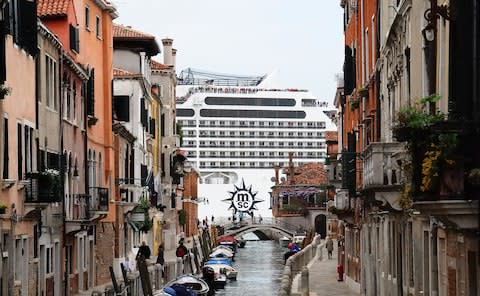Where's the next Venice? New report highlights the cities under threat from tourist overcrowding

The problem of tourist overcrowding that has blighted cities such as Barcelona and Venice in recent years could soon reach Lisbon, Prague and Marrakech, a new report has warned.
Research by the World Travel and Tourism Council (WTTC) has concluded that there is no silver bullet for the issue of travellers overrunning destinations, but that locations and governments must act if they are to avoid falling victim to what has been known as “tourismphobia”.
This year has seen Dubrovnik announce drastic limits on entry into its Old Town, protests on the Grand Canal in Venice and sightseeing buses attacked in Barcelona.
The authors of the WTTC report, Coping with Success, assessed 68 cities around the world and gauged their vulnerability to a similar crisis, cautioning that “when overcrowding goes too far, the repercussions are difficult to reverse”.
Judging destinations according to several criteria, including growth in arrivals, tourism density and threats to local culture, the WTTC said European hotspots including Budapest, Prague, Lisbon and Warsaw were suffering from one or more of the symptoms.

For example, the Polish capital was found to have both a high density of tourism and tourism intensity - calculated by visitors per square kilometre and visitors per resident - and a limited “arrival seasonality”.
Lisbon, the Portuguese capital, suffers too from limited seasonality, and a medium level of growth in arrivals and tourism dependence.
Global destinations recording concerning levels of the different factors included Tokyo, where arrivals growth was high, Orlando, which has a high tourism intensity, and Lima.

The WTTC said overcrowding can lead to five problems:
Alienated local residents
Degraded tourist experience
Overloaded infrastructure
Damage to nature
Threats to culture and heritage
“As almost any traveller can attest, the world has many destinations whose appeal, or even essence, is being undermined by overcrowding,” said the WTTC. “A cursory look at social media sites associated with tourism reveals a deep undercurrent of dissatisfaction.”
It cited a number of examples:
“In Venice, tourists are actually displacing locals. In just 30 years, the city’s population was cut in half, to 55,000, and locals continue to move to the mainland to escape the tourist influx - a phenomenon known as Ven-exodus.
“In many places, the tourist experience itself is deteriorating due to queues, crowding, or simply annoyance. One has only to see the crowds jammed against the velvet rope in front of the Mona Lisa to wonder if this is really the ideal way to view an artistic masterpiece.
Surprising alternatives to Europe’s most overcrowded cities
“India’s beautiful city of Jaisalmer has seen tourism grow sharply. This has been good for the local economy, but the sewage system has not been able to keep up, and leaks threaten the integrity of the classical sandstone.
“Misbehaviour by a few is scarring some of the world’s great monuments, including the Great Wall and Cambodia’s Angkor Wat, which have been marred by graffiti.”
Gloria Guevara, WTTC president, said: “Tourism is a force for good in the world. It creates jobs and economic growth. With the world getting richer - one billion more people will be in the global middle class by 2030 - and travel becoming ever more accessible, our sector will continue to grow.

“Where tourism growth is perceived negatively, each destination has a specific set of problems and challenges, but the common factor is that what is needed is long-term planning not short-term knee-jerk reactions. Local tourism managers must work with all public, private, and community stakeholders to develop a coherent plan to create and manage tourism growth.”
Among the solutions offered by the WTTC were imposing limits and restrictions on particularly vulnerable sights, as witnessed at France’s Lascaux Cave and Australia’s Uluru, a regulation of accommodation supply, such as the banning of short-term rentals in New Orleans’ French Quarter, and the promotion of lesser-visited attractions, like Scotland’s North Coast 500 route or the push to encourage visitors to Iceland to the north of the country, to places such as Akureyri.
At a glance | The world's 10 most visited cities
“Adjusting pricing” was also suggested. However, caution was urged. “The perception that a destination is raising revenues... without a clear purpose can damage its reputation and cause visitors to lose trust.”
The WTTC said it hopes the report acts as a foundation for an ongoing discussion on the issue.
“The challenges of growth, and particularly overcrowding, are apparent, but many destinations are struggling to strike the right balance of meeting the needs of businesses, local residents, and tourists.
“The goal of our work is to bring structure and facts to an issue that has long been characterized by anecdote and emotion.”

